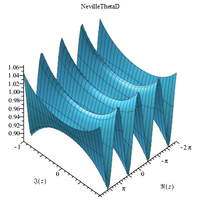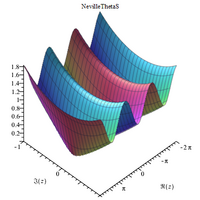(Redirected from Neville theta function )
For other θ functions, see Theta function (disambiguation) .
In mathematics, the Neville theta functions , named after Eric Harold Neville , are defined as follows:
θ
c
(
z
,
m
)
=
2
π
q
(
m
)
1
/
4
m
1
/
4
K
(
m
)
∑
k
=
0
∞
(
q
(
m
)
)
k
(
k
+
1
)
cos
(
(
2
k
+
1
)
π
z
2
K
(
m
)
)
{\displaystyle \theta _{c}(z,m)={\frac {{\sqrt {2\pi }}\,q(m)^{1/4}}{m^{1/4}{\sqrt {K(m)}}}}\,\,\sum _{k=0}^{\infty }(q(m))^{k(k+1)}\cos \left({\frac {(2k+1)\pi z}{2K(m)}}\right)}
θ
d
(
z
,
m
)
=
2
π
2
K
(
m
)
(
1
+
2
∑
k
=
1
∞
(
q
(
m
)
)
k
2
cos
(
π
z
k
K
(
m
)
)
)
{\displaystyle \theta _{d}(z,m)={\frac {\sqrt {2\pi }}{2{\sqrt {K(m)}}}}\,\,\left(1+2\,\sum _{k=1}^{\infty }(q(m))^{k^{2}}\cos \left({\frac {\pi zk}{K(m)}}\right)\right)}
θ
n
(
z
,
m
)
=
2
π
2
(
1
−
m
)
1
/
4
K
(
m
)
(
1
+
2
∑
k
=
1
∞
(
−
1
)
k
(
q
(
m
)
)
k
2
cos
(
π
z
k
K
(
m
)
)
)
{\displaystyle \theta _{n}(z,m)={\frac {\sqrt {2\pi }}{2(1-m)^{1/4}{\sqrt {K(m)}}}}\,\,\left(1+2\sum _{k=1}^{\infty }(-1)^{k}(q(m))^{k^{2}}\cos \left({\frac {\pi zk}{K(m)}}\right)\right)}
θ
s
(
z
,
m
)
=
2
π
q
(
m
)
1
/
4
m
1
/
4
(
1
−
m
)
1
/
4
K
(
m
)
∑
k
=
0
∞
(
−
1
)
k
(
q
(
m
)
)
k
(
k
+
1
)
sin
(
(
2
k
+
1
)
π
z
2
K
(
m
)
)
{\displaystyle \theta _{s}(z,m)={\frac {{\sqrt {2\pi }}\,q(m)^{1/4}}{m^{1/4}(1-m)^{1/4}{\sqrt {K(m)}}}}\,\,\sum _{k=0}^{\infty }(-1)^{k}(q(m))^{k(k+1)}\sin \left({\frac {(2k+1)\pi z}{2K(m)}}\right)}
where: K(m) is the complete elliptic integral of the first kind,
K
′
(
m
)
=
K
(
1
−
m
)
{\displaystyle K'(m)=K(1-m)}
q
(
m
)
=
e
−
π
K
′
(
m
)
/
K
(
m
)
{\displaystyle q(m)=e^{-\pi K'(m)/K(m)}}
Note that the functions θp (z,m) are sometimes defined in terms of the nome q(m) and written θp (z,q) (e.g. NIST). The functions may also be written in terms of the τ parameter θp (z|τ) where
q
=
e
i
π
τ
{\displaystyle q=e^{i\pi \tau }}
Relationship to other functions
The Neville theta functions may be expressed in terms of the Jacobi theta functions
θ
s
(
z
|
τ
)
=
θ
3
2
(
0
|
τ
)
θ
1
(
z
′
|
τ
)
/
θ
1
′
(
0
|
τ
)
{\displaystyle \theta _{s}(z|\tau )=\theta _{3}^{2}(0|\tau )\theta _{1}(z'|\tau )/\theta '_{1}(0|\tau )}
θ
c
(
z
|
τ
)
=
θ
2
(
z
′
|
τ
)
/
θ
2
(
0
|
τ
)
{\displaystyle \theta _{c}(z|\tau )=\theta _{2}(z'|\tau )/\theta _{2}(0|\tau )}
θ
n
(
z
|
τ
)
=
θ
4
(
z
′
|
τ
)
/
θ
4
(
0
|
τ
)
{\displaystyle \theta _{n}(z|\tau )=\theta _{4}(z'|\tau )/\theta _{4}(0|\tau )}
θ
d
(
z
|
τ
)
=
θ
3
(
z
′
|
τ
)
/
θ
3
(
0
|
τ
)
{\displaystyle \theta _{d}(z|\tau )=\theta _{3}(z'|\tau )/\theta _{3}(0|\tau )}
where
z
′
=
z
/
θ
3
2
(
0
|
τ
)
{\displaystyle z'=z/\theta _{3}^{2}(0|\tau )}
The Neville theta functions are related to the Jacobi elliptic functions . If pq(u,m) is a Jacobi elliptic function (p and q are one of s,c,n,d), then
pq
(
u
,
m
)
=
θ
p
(
u
,
m
)
θ
q
(
u
,
m
)
.
{\displaystyle \operatorname {pq} (u,m)={\frac {\theta _{p}(u,m)}{\theta _{q}(u,m)}}.}
Examples
θ
c
(
2.5
,
0.3
)
≈
−
0.65900466676738154967
{\displaystyle \theta _{c}(2.5,0.3)\approx -0.65900466676738154967}
θ
d
(
2.5
,
0.3
)
≈
0.95182196661267561994
{\displaystyle \theta _{d}(2.5,0.3)\approx 0.95182196661267561994}
θ
n
(
2.5
,
0.3
)
≈
1.0526693354651613637
{\displaystyle \theta _{n}(2.5,0.3)\approx 1.0526693354651613637}
θ
s
(
2.5
,
0.3
)
≈
0.82086879524530400536
{\displaystyle \theta _{s}(2.5,0.3)\approx 0.82086879524530400536}
Symmetry
θ
c
(
z
,
m
)
=
θ
c
(
−
z
,
m
)
{\displaystyle \theta _{c}(z,m)=\theta _{c}(-z,m)}
θ
d
(
z
,
m
)
=
θ
d
(
−
z
,
m
)
{\displaystyle \theta _{d}(z,m)=\theta _{d}(-z,m)}
θ
n
(
z
,
m
)
=
θ
n
(
−
z
,
m
)
{\displaystyle \theta _{n}(z,m)=\theta _{n}(-z,m)}
θ
s
(
z
,
m
)
=
−
θ
s
(
−
z
,
m
)
{\displaystyle \theta _{s}(z,m)=-\theta _{s}(-z,m)}
Complex 3D plots
Notes
The Mathematical Functions Site
The Mathematical Functions Site
^ Olver, F. W. J.; et al., eds. (2017-12-22). "NIST Digital Library of Mathematical Functions (Release 1.0.17)" . National Institute of Standards and Technology. Retrieved 2018-02-26.
References
Categories :
Text is available under the Creative Commons Attribution-ShareAlike License. Additional terms may apply.
**DISCLAIMER** We are not affiliated with Wikipedia, and Cloudflare.
The information presented on this site is for general informational purposes only and does not constitute medical advice.
You should always have a personal consultation with a healthcare professional before making changes to your diet, medication, or exercise routine.
AI helps with the correspondence in our chat.
We participate in an affiliate program. If you buy something through a link, we may earn a commission 💕
↑








 , and
, and  is the elliptic nome.
is the elliptic nome.
 .
.




 .
.








